Introduction
Forged components play a vital role in industries where durability, precision, and strength are paramount. Forging, which involves shaping metal under compressive forces, ensures that components possess superior mechanical properties and structural integrity. Various industries rely heavily on forged parts to meet demanding operational requirements. This article explores the top industries that benefit from forged components and highlights their critical applications.
Motor manufacturers
Critical Engine and Transmission Parts
The motor manufacturers depend on forging for essential engine components, including crankshafts, camshafts, and connecting rods. These forged parts withstand high temperatures and stress, ensuring reliability. Transmission gears and axles also rely on forging to handle the mechanical load from continuous vehicle operation.
Steering, Axles, and Suspension Components
Forged steering knuckles, suspension arms, and axles provide enhanced durability, critical for vehicle safety. The use of forged components in these systems ensures a smooth ride while maintaining structural integrity over time.
Aerospace Industry
High-Strength Structural Parts
The aerospace sector demands lightweight yet strong materials. Forged parts, such as landing gear and wing components, offer the ideal combination of strength and weight reduction. These components endure the extreme pressure changes that occur during flight.
Forged Components in Jet Engines
Jet engines require precision-forged parts like turbine disks and compressor blades to perform reliably under extreme heat and rotational forces. The precision of aerospace-grade forging ensures maximum efficiency and safety.
Construction and Heavy Machinery
Hydraulic Components and Excavation Tools
In the earth moving industry, forging is used for hydraulic parts that drive machinery like cranes and excavators. These components handle heavy loads, ensuring efficient operations on job sites. Forged tools, such as chisels and hammers, are essential for tasks requiring strength and endurance.
Large-Scale Machinery Parts for Durability
Earthmoving equipment and large industrial machines rely on forged gears and shafts to operate smoothly. These forged components offer high resistance to wear, ensuring the longevity of equipment used in demanding environments.
Oil and Gas Sector
Forged Valves, Fittings, and Drill Bits
The oil and gas industry uses forged valves, fittings, and drill bits that can withstand high pressure and corrosive environments. These components are crucial in exploration and refining operations, maintaining safety and efficiency.
Pressure-Resistant Components
Forged flanges and couplings are essential in pipeline systems. They ensure secure connections and reduce the risk of failure under high pressure, making them vital in offshore and onshore drilling applications.
Defense and Military Applications
Armored Vehicles and Weaponry Components
The defense industry relies on forging for key components in armored vehicles, weapon systems, and ammunition. Forged gun barrels and vehicle frames enhance durability, providing reliability in combat situations.
Aircraft and Naval Ship Parts
Military aircraft and ships use forged parts for structural support. These components withstand extreme environmental conditions, ensuring performance and safety in defense operations.
The Role of Forging in Ensuring Safety and Reliability
Improved Mechanical Properties
Forged components offer enhanced mechanical properties, including wear resistance and structural integrity. These attributes make them indispensable for industries where safety is a top priority.
Increased Fatigue and Impact Resistance
The forging process aligns metal grains, improving resistance to fatigue and impact. This ensures components last longer, reducing the risk of unexpected failures in critical applications.
Advancements in Forging Technology Across Industries
Automation and Precision Forging
Technological advancements, such as automated forging processes, enhance precision and efficiency. This ensures higher consistency across production batches, meeting stringent industry standards.
Lightweight Forged Materials
Innovations in forging allow for the use of lightweight materials, especially in the aerospace and automotive sectors. These materials improve fuel efficiency without compromising strength.
Challenges in the Forging Industry
Material Costs and Energy Consumption
Forging is resource-intensive, requiring significant energy and high-quality raw materials. Rising costs in both areas pose challenges, prompting the industry to adopt more efficient practices.
Meeting Stringent Industry Standards
Industries such as aerospace and defense impose strict quality standards on forged components. Maintaining compliance demands constant quality control and innovation within the forging process.
Conclusion
From motor manufacturers and aerospace to oil and gas, forged components play a crucial role in ensuring reliability and performance. The advantages of forging—enhanced durability, precision, and fatigue resistance—make it indispensable across multiple industries. As forging technology evolves, it continues to meet the rigorous demands of modern applications, solidifying its position as a critical manufacturing process.



